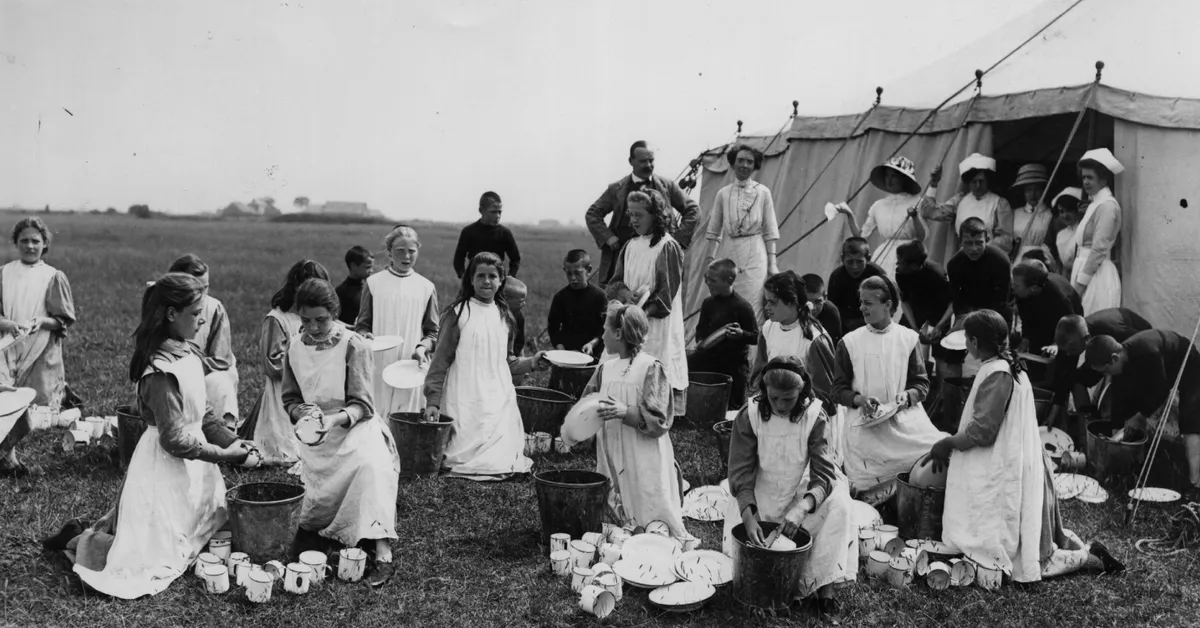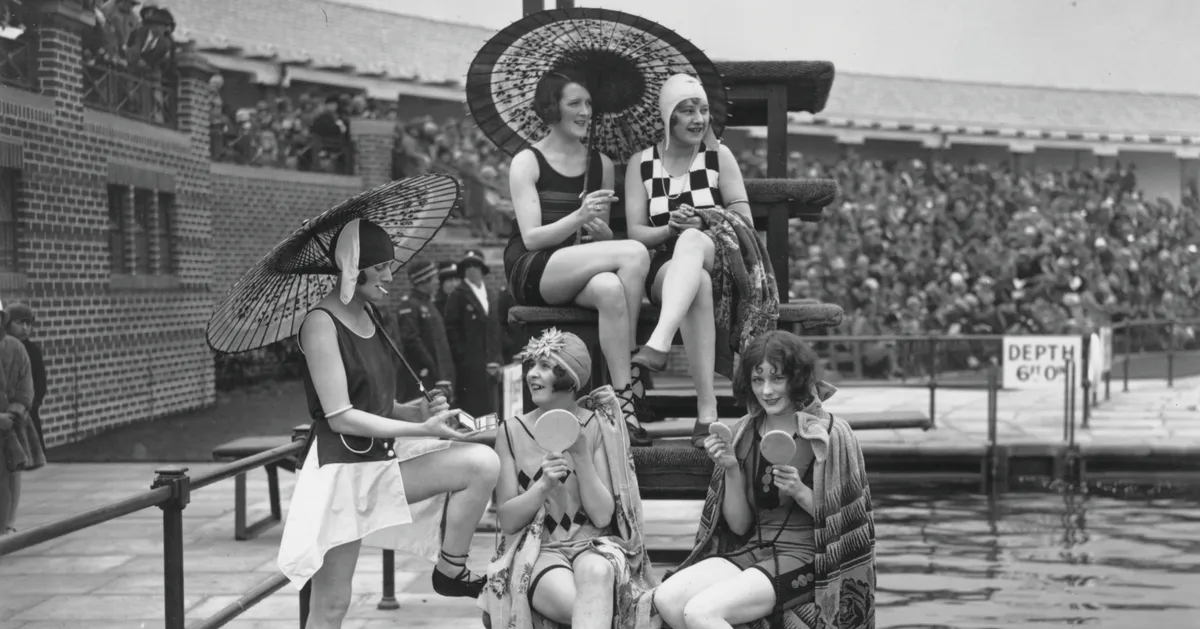A young William Butlin holidayed at a boarding house on Barry Island, South Wales, in the early 1920s. The holiday was memorable for all the wrong reasons. As he later recalled in his book The Billy Butlin Story: A Showman to the End (1982), “I was astounded by the way the guests were treated. We had to leave the premises after breakfast and were not encouraged to return until lunchtime. After lunch we were again made not welcome until dinner in the evening… When it rained life became a misery. I felt sorry for myself but I felt sorrier for the families with young children as they trudged around wet and bedraggled… until they could return to their boarding houses.”
Butlin’s experience would change the British holiday camp forever. When he opened his first camp in Skegness in 1936 under the slogan “Our true intent is all for your delight”, his all-in-one offering – in which food, accommodation and entertainment were included – revolutionised holidays for the masses. However, the first holiday camp had in fact been operating for over 40 years before Butlin entered the market.
Prior to Butlin and his contemporaries, Fred Pontin and Harry Warner, holiday camps were operated by philanthropic organisations to give poor city children a taste of the great outdoors. Campers slept in round tents, and would partake in drills and tent inspections. In 1894, Joseph and Elizabeth Cunningham opened a camp on the Isle of Man for children from Liverpool. It evolved into a commercial operation, becoming Cunningham Young Men’s Holiday Camp. By 1908 it had acquired all the hallmarks of the later camps, such as a communal dining hall, swimming pool and concert hall.

Another early entrepreneur was John Fletcher Dodd, who in 1906 camped with a group of trade-unionist friends on the Norfolk coast. Dodd reasoned that with more tents and a captive audience he could spread his message to the masses. The Socialist Holiday Camp combined campfire singing with debates and a Sunday evening lecture. The camps in the early 20th century were basic, but they proved that the model of a cheap, ‘all-in-one’ holiday could work on a grander scale.
The coast quickly became a favourite spot. The 10-mile stretch of coastline either side of the border between Norfolk and Suffolk had 14 camps alone, prompting critics to decry “the tottering railway wagons, the lopsided huts, the corrugated iron, littering the landscape like a Chinatown of the fields” (Hull Daily Mail, February 1937). Herbert ‘Pa’ Potter was one of the first owners to provide a solid alternative to the traditional tent. When he opened his camp in Hemsby, Norfolk, in 1920, it had timber huts. These were upgraded to brick-built chalets when he launched his Hopton Beach Camp in 1933. In the same year, Captain Harry Warner set up a camp on Hayling Island, Hampshire, offering four-course meals, a bar, entertainment room and seawater swimming pool. By the 1930s commercial and non-commercial camps were operating side by side, evolving together as they borrowed from and competed with each other.
By 1938, Britain had about 150 holiday camps. Customer loyalty was high – due in part to the big personalities behind the brands, such as Warner, Potter and Butlin. From the outset, Billy had a clear idea of his potential guests – middle-income families looking for a taste of the glamour that was portrayed in films and popular magazines of the time. The interwar pursuit of health and fitness, combined with open-air activities such as sunbathing at the lido or hiking in the hills, provided the perfect backdrop for the holiday camp to flourish.

The ‘all-in’ charge at Butlin’s first camp in Skegness included “Glorious Golden and Silver Sands” as well as “sports and pastimes”, for example boating, golf, bathing, tennis and often free tuition as well (Skegness Standard, September 1935). Different combinations of beds and types of chalet were available, often painted in bright, cheery colours to create a sunny atmosphere. Washbasins with a supply of cold water were provided, while hot water could be sourced from a communal tap, usually located in the toilet and bath block at the end of the chalet line. Basic furniture such as a wardrobe was included, as well as a chalet maid, who would keep things tidy and make the beds. Butlin’s Elizabethan-style chalets featured mock-Tudor exposed beams. Chalets were often built in a rustic-cottage style, promoting the idea of a home-from-home, but communal areas such as the dining and entertainment spaces were modern and built to impress, borrowing ideas from ocean liners and Art Deco cinemas.
Entertainment and activities were a mainstay, as well as celebrities and sporting stars. Actor and singer Gracie Fields, cricketer Len Hutton and ballroom champion Victor Silvester all graced the holiday camps offering entertainment or instruction. In addition there were beauty contests and talent shows. Galas were held in open-air swimming pools, while keep-fit classes jogged and stretched on the lawns. Couples could dance the night away to live music in vast ballrooms, with instructors on hand to help them brush up on their technique. Enthusiastic, smartly uniformed staff – the iconic Redcoats at Butlin’s, and the Bluecoats and Greencoats at Pontin’s and Warner’s – encouraged guests to join in with the array of activities on offer.
With hundreds of hungry campers to feed, meals would be served in two sittings. An alarm call – disguised as a catchy song – summoned campers at their allotted time, and a vast team of waiters and waitresses ensured things ran smoothly. The offer of accommodation with meals was very appealing to housewives, especially with free crèche facilities included. Older children were entertained by ‘aunties’ and ‘uncles’ who took them on discovery walks and performed shows, giving families the opportunity to be occupied in different ways at the same time. As one former camper recalled: “Our parents would only see us at mealtimes, as it was perfectly safe then to go off and do your own thing with your brothers and sisters.”

The outbreak of the Second World War presented a new challenge to camp operators, who found their sites requisitioned for military use, but the years following the Second World War were a golden age. Some 11 million workers were entitled to a week of paid leave, and countless families wanted an affordable break near the beaches that had been out of bounds during wartime. Quick to spot an opportunity, Fred Pontin bought Brean Sands in Somerset – a small, former US Army base. After a quick revamp and an advert in the Sunday Express it was soon overrun with campers. Pontin replicated his success across five further sites in a year. His camps were nowhere near the scale of Butlin’s, but keeping overheads low allowed him to keep rates low, ensuring a steady stream of guests.
By the 1950s the holiday camp was the ultimate symbol of postwar modernity, and the decades following the war were one of prosperity for the industry. In 1963, Butlin’s exceeded a million campers a year and all of the major operators were expanding their portfolios. New options were incorporated to meet changing expectations, for example self-catering and en-suite bathrooms.
Despite this, cheap charter flights to new, exotic locations meant that holiday camps started to lose their appeal. Many rebranded as ‘villages’ or ‘holiday centres’. When the Dutch firm Center Parcs launched in the UK in 1987, bringing woodland villas and the spirit of self-discovery, the death knell was already tolling for the traditional camps. Butlin’s retained three sites in Skegness, Bognor Regis and Minehead, and Warner’s entered the adults-only market by revamping historic houses as upmarket hotels. Pontin’s camps were bought and sold several times, and are now owned by Britannia Hotels.
Holiday camps offered mid-20th-century pleasure-seekers something new and exciting. While their architecture hasn’t lasted the distance – except for the Grade II-listed ‘Elizabethan’ chalet at Butlin’s camp in Skegness – for many of our relations, the memories they made at these iconic camps lasted a lifetime.
